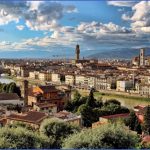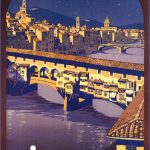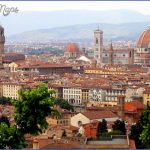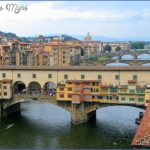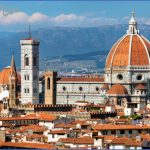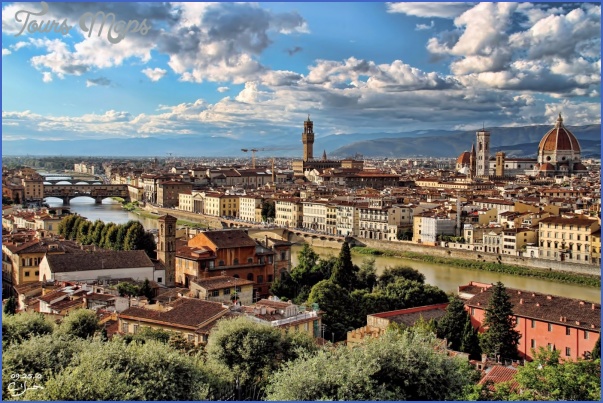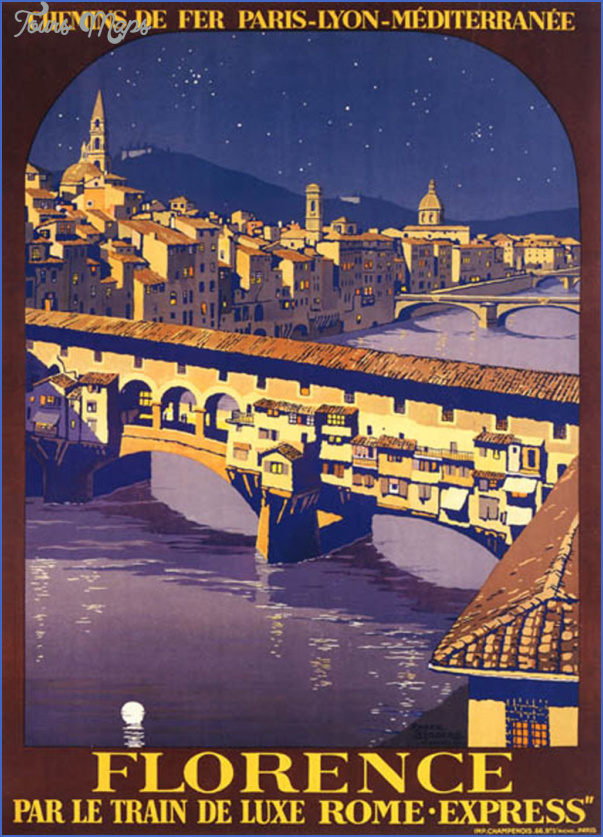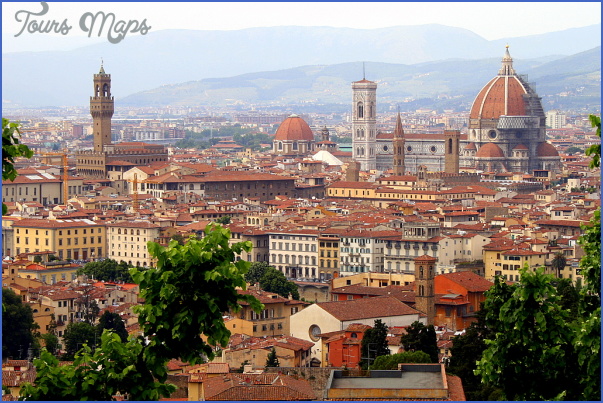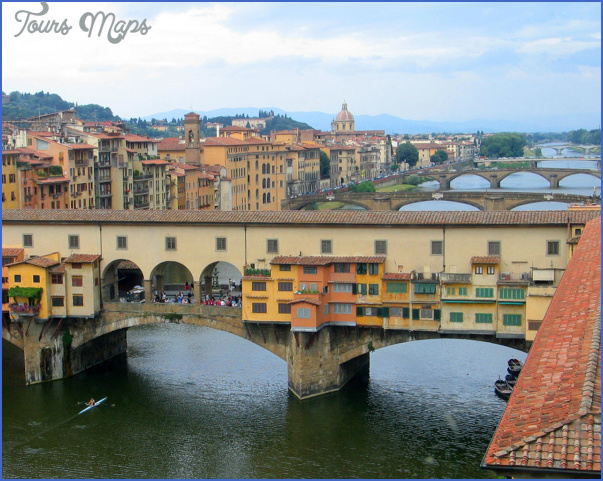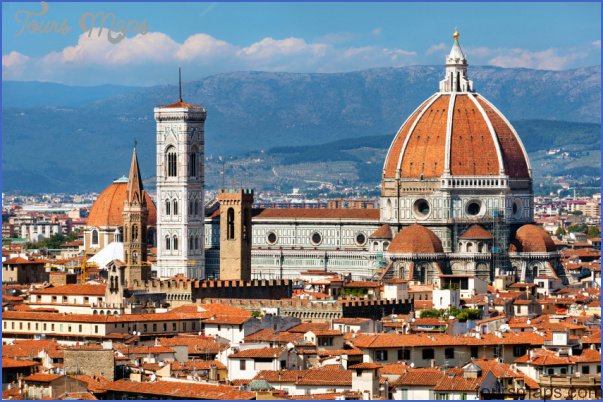SAN LORENZO AND FARTHER NORTH
BASILICA DI SAN LORENZO. The Medici, who lent the city the funds to build the church (designed in 1419 by Brunelleschi), retained artistic control over its construction. The family cunningly placed Cosimo Medici’s grave in front of the high altar, making the entire church his personal mausoleum. Michelangelo designed the exterior but, disgusted by Florentine politics, he abandoned the project to study architecture in Rome. ( 055 21 66 34. Open daily M-Sa 10am-5pm. ‚2.50.)
To reach the SCappelle del Medici (Medici Chapels), walk around to the back entrance on P. Madonna degli Aldobrandini. The Cappella dei Principi (Princes’ Chapel) is a rare example of Baroque style in Florence, while the Sacrestia Nuova (New Sacristy) shows Michelangelo’s work and holds two Medici tombs. (Open daily 8:15am-5pm. Closed the 2nd and 4th Su and the 1st, 3rd, and 5th M of every month. ‚6.) The adjacent Laurentian Library houses one of the world’s most valuable manuscript collections. Michelangelo’s famous entrance portico confirms his virtuosity; the elaborate pietra serena sandstone staircase is one of his most innovative architectural designs. (Open daily 8:30am-l:30pm. Free with entrance to San Lorenzo.)
HIMUSEO DELLA CHIESA DI SAN MARCO. Remarkable works by Fra Angelico adorn the Museo della Chiesa di San Marco, one of the most peaceful and spiritual places in Florence. A large room to the right of the lovely courtyard contains some of the painter’s major works, including the church’s altarpiece. The second floor houses Angelico’s most famous Annunciation, across from the top of the stairwell, as well as the monks’ quarters. Every cell in the convent contains its own Fra Angelico fresco, each painted in flat colors and with sparse detail to facilitate the monks’ somber meditation. To the right of the stairwell, Michelozzo’s library, modeled on Michelangelo’s work in S. Lorenzo, is a fine example of purity and vigor. After visiting, you may want to follow in the footsteps of the convent’s patron, Cosimo I, who retired here. In cells 17 and 22, you can see underground artwork through the glass floor, excavated from the medieval period. Towards the exit are two rooms housing the Museo di Firenze Antica, which is worth a quick visit. It has numerous archeological fragments on display, most of them from Etruscan and Roman buildings in the area. (Enter at P. di San Marco, 3. 055 238 86 08 or 238 87 04. Open daily 8:15am-6:50pm. Closed 1st, 3rd, and 5th Su and 2nd and 4th M of every month. ‚4. Over-65 or under-18 free.)
ACCADEMIA. Michelangelo’s triumphant David stands in self-assured perfection under the rotunda designed just for him. In a series of unfortunate incidences, the statue’s base was struck by lightning in 1512, damaged by anti-Medici riots in 1527, and was finally moved here from P. della Signoria in 1873 after a stone hurled during a riot broke David’s left wrist in two places. In the hallway leading up to the David are Michelangelo’s four Slaves and aPieta. The master left these intriguing statues intentionally unfinished. Remaining true to his theories of living stone, he chipped away only enough to show their emerging figures. In addition to the commanding sculptures, check out Botticelli’s Madonna paintings as well as works by Uccello. (V. Ricasoli 60 between the churches of San Marco and S.S. Annunziata. Most areas wheelchair accessible. Open Su and Tu-Sa 8:15am-6:50pm. ‚6.50.)
PALAZZO MEDICI RICCARDI. The palace’s innovative facade is the work of Michelozzo it stands as the archetype for all Renaissance palazzi. The private chapel inside features Benozzo Gozzoli’s beautiful, wrap-around fresco of the DfThree Magi and several Medici family portraits. The palazzo hosts rotating exhibits ranging from Renaissance architectural sketches to Fellini memorabilia. (V. Cavour 3. 055 276 03 40. Open daily 9am-lpm and 3-7pm. ‚4, children ‚2.50.)
MUSEO ARCHEOLOGICO. Unassuming behind its bland, yellow plaster facade and small sign, the archeological museum has a surprisingly diverse collection. Inside, you’ll find notable collections of statues and other monuments of the ancient Greeks, Etruscans, and Egyptians. A long, thin, two-story gallery devoted to Etruscan jewelry runs along the length of the plant- and tree-filled courtyard. In almost any other city in the world, this museum would be a major cultural highlight, but in Florence, it’s possible to enjoy it without large crowds. (V. della Colonna 38. Open M 2-7pm, Tu and Th 8:30am-7pm, W and F-Su 8:30am-2pm. ‚4.)
PIAZZA SANTA CROCE AND ENVIRONS
CHIESA DI SANTA CROCE. The thrifty Franciscans ironically built the city’s most splendid church. Among the luminaries buried here are Machiavelli, Galileo, Michelangelo (who rests in the right aisle in a tomb designed by Vasari), and humanist Leonardo Bruni, shown holding his precious History of Florence. Note also Donatello’s gilded Annunciation. (Open M-Sa 9:30am-5:30pm, Su and holidays 3-5:30pm.) Intricate pietra serena pilasters and statues of the evangelists by Donatello grace Brunelleschi’s small Cappella Pazzi, at the end of the cloister next to the church, a humble marvel of perfect proportions and lovely decorations, among them Luca della Robbia’s tondi of the apostles and Brunelleschi’s moldings of the evangelists. (Enter through the Museo dell’Opera. Open Su-Tu and Th-Sa 10am-7pm. ‚2.60.) The Museo dell’Opera di Santa Croce forms three sides of the church’s peaceful courtyard with gravel paths and cypress trees. (Enter museum through the loggia in front of Cappella Pazzi. Open Su-Tu and Th-Sa 10am-7pm.)
SYNAGOGUE OF FLORENCE. This synagogue, also known as the Museo del Templo Israelitico, lies hidden behind gates and walls, waiting to reveal its Sephardic temple’s domes, arches, and patterns. David Levi, a wealthy Florentine Jewish business man, donated his fortune in 1870 for the construction of a monumental temple worthy of Florence, in recognition of the fact that Jews had recently been allowed to live and worship outside the old Jewish ghetto. Architects Micheli, Fal-chi, and Treves created one of Europe’s most beautiful synagogues. (V. Fahni 4, at V. Pilastri. The museum includes free, informative tours every hr.; book in advance. 055 24 52 52. Open Su-Th 10am-6pm, F 10am-2pm. ‚4.)
CASA BUONARROTI. This unassuming little museum houses Michelangelo memorabilia and two of his most important early works, The Madonna of the Steps and The Battle of the Centaurs. Both pieces sure to the left of the second floor landing. He completed these panels, which illustrate his growth from bas-relief to sculpture, when he was only 16 years old. A selection of his sketches is on rotating display from the unusually large collection; before he died, Michelangelo burned most of his sketches and preliminary work lest he should appear less than perfect. (V. Ghibellina 70. From P.S. Croce, follow I, dei Pepi and turn right onto V. Ghibellina. &055 24 17 52. Open Su-M and W-Sa 9:30am-2pm. ‚6.50, students ‚4.)
Florence Travel Photo Gallery
Maybe You Like Them Too
- Explore Góra Kalwaria, Poland with this detailed map
- Explore Gumdag, Turkmenistan with this detailed map
- Explore Telfes im Stubai, Austria with this detailed map
- Explore Doncaster, United Kingdom with this detailed map
- Explore Arroyito, Argentina with this Detailed Map

